I have been meaning to write this post for the last few months … so now finally today…. I want to share with you my thoughts on a wonderful new book by James(Jim) Richards called Freehand Drawing & Discovery – Urban Sketching and Concept Drawing for Designers.
I have known Jim online for a number of years and was privileged to meet him in real life at the USK symposiums in Lisbon and Santo Domingo. He is a great friend and a huge source of inspiration to me. When I first came across an article he wrote in 2009 called Freehand Renaissance I was buzzing for days afterwards!!! This book is an amazing expansion of that article and I want to share with you my takeaways from it. I am not intending this to be a formal book review, although it might end up that way!
The reason why I am so excited about this book is that combines the two important aspects of my sketching – being an architect and an compulsive urban sketcher. It explains how the two are inter-related and support each other and also why I work so fast! The creative thrill that I get when I am ‘design sketching’ (the moment when a solution appears on the page) that has greatly influenced the speed at which I do my ‘urban sketching’. I am trying to work at a pace out on the streets that generates the spontaneity, freedom and excitement I get when ‘design sketching’.
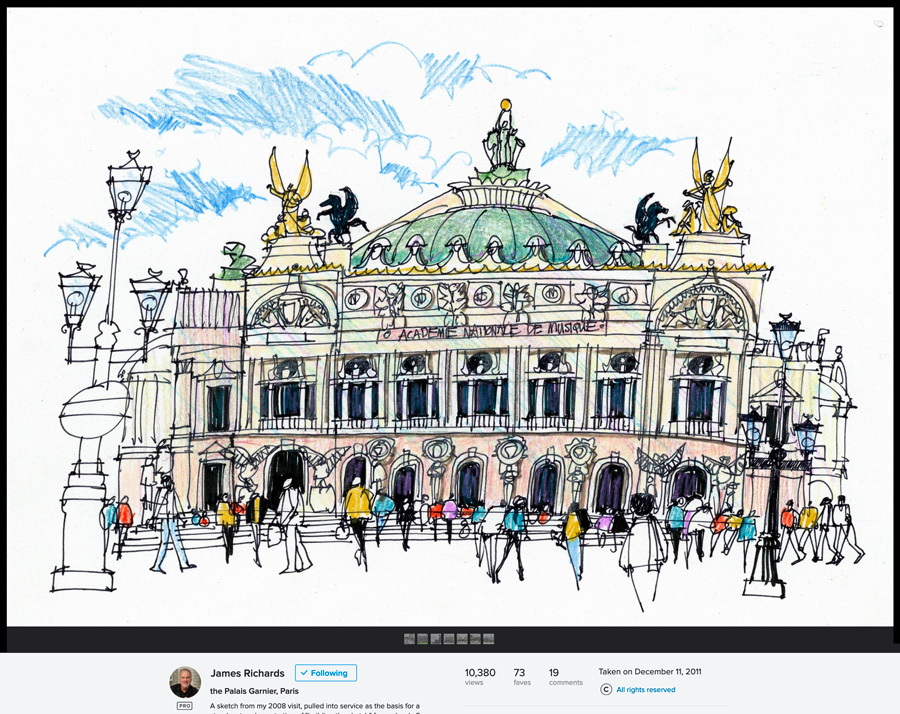
Palais Garnier, Pars by James Richards – great step by step of this work in the book and on his blog
I absolutely adore Jim’s work. His lines are so crisp and confident and I am in awe of his ability to simplify complex scenes into a compelling composition. Jim and I speak the same language but, in the words of Frank Ching in the preface “my drawings are much messier than Jim’s”.
I really wish I had had this book at the start on my architectural education as it would have helped me to create my own visual language much more easily and quickly. I will be writing the following comments on the book primarily with my architect’s hat on – though much will relate to urban sketchers as well.
I devoured the written text in this book and couldn’t put it down. It is so readable and inspiring (especially Chapter 1) and this paragraph says it all for me:
“the rapid sketching skills practiced and sharpened in the field develop confidence in our own abilities to strike out into the imagination. Drawing becomes an exploratory process of discovery, in which visual ideas in the mind are immediately given shape, examined, reworked and refined, becoming a catalyst for more ideas, When married with the magic of digital technologies, the creative possibilities are limitless.”
There are 3 sections to the book… (hmm, looks like I am doing a formal book review)
Part 1: Learning a Language – creating a visual language of techniques, textures and entourage to enable quick convincing conceptual sketches
Part 2: Urban Sketching – Creative play and fuel! On location sketching sharpens the eye, trains the hand, develops speed and confidence as you discover more of the world around you.
Part 3: Concept Sketching – Envisioning and sketching the world as it could be. Making the most of the skills developed in Part 1 and 2 with the addition of digital technologies. Making the most of digital tools.
Part 4: there is no part 4 in the book but wait there IS more. A heap of videos can be accessed on the Wiley website. I have to say that these videos are BRILLIANT and add so much to the book. There is a lot to be learnt from watching Jim in action!
My personal takeaways and general comments:
– Part 1 summarises so well what took me many years to develop. As designers we need to have a visual language and reliable techniques that we can use to quickly explore ideas for ourselves and our clients. Simplified perspective setups, useful textures and simple but convincing ‘entourage’ (people, cars, trees etc) are essential for this.
– Jim provides many great tips for basic ways of indicating people, trees, cars and other entourage. This is not observational drawing but a language to be used in our design concept sketching and therefore could be labelled “architect style” or “stylised”. These techniques may be very useful for sketchers in general as a springboard for developing their own approach but I think it is important that when out on location we focus on observational skills and not on ‘formulas’
-Really clear is the message to simplify!! Simplify tools, and forms – and have a strong focus. Jim’s work is so clear and strong!
– I really love Jim’s “draw people first” approach – it really works and I plan to show you some examples in the coming months!
– The book contains some of the clearest step by step explanations I have seen for a long time – perspective setups, creating depth by defining foreground, middle ground and background. Jim’s general approach is so clear – horizon line & people – overall proportions – details- darks – colour.
– It is very exciting to see the combination of freehand sketching and digital images – this is something I have done with my architectural work for a number of years and I got more great ideas from this section of the book
– As I said above the videos are great… and I was totally blown away by a simple (and somewhat obvious… now!) trick of Jim’s when drawing perspective so that you don’t get 100 drawn lines converging on the vanishing point – I am not going to describe it any more. Get the book and watch the videos for yourself!
I have studied a number of architectural rendering books in the past showing how to create beautiful final artworks for ‘final presentations’ of schemes – these have largely being taken over by computer generated images. The great strength of the message of this book is that it is advocating loose rapid sketching at the beginning of the design process. Another quote that really resonated with me:
“The goal of sketching isn’t a perfect finished illustration at the end of the creative process, it is to serves as a catalyst for more and better ideas at the beginning.”
In a way that sums up the book for me – my wish is that the architectural profession never looses the importance of sketching as its most powerful tool to develop the best possible design solutions for the world around us. The best way I know of to keep the love of sketching and freehand discovery alive is by urban sketching!
I feel honoured beyond words to be included in this book along with a number of other friends and USKers in the book (Gabi Campanario, Luis Ruiz, Asnee Tasna, Paul Wang, Bernadetta Dossi)…. this post is not about my pages but the book as a whole… but just for the record here is a glimpse of my contribution.
I end with my words from the book which is the key for me…
There are so many reasons why sketching is invaluable to my design process, but the most important is that it is so immediate and responsive. Not only can I explore many options simultaneously, drawing almost as fast as I am thinking, but in some mysterious way, solutions seem to emerge from my open-ended scribbles on the page. That moment of inspiration is instantly recorded in a sketch which often powerfully depicts the very heart of the design idea. It is this excitement and the inspiring dialogue which occurs between eye, hand, and mind that keeps me going!

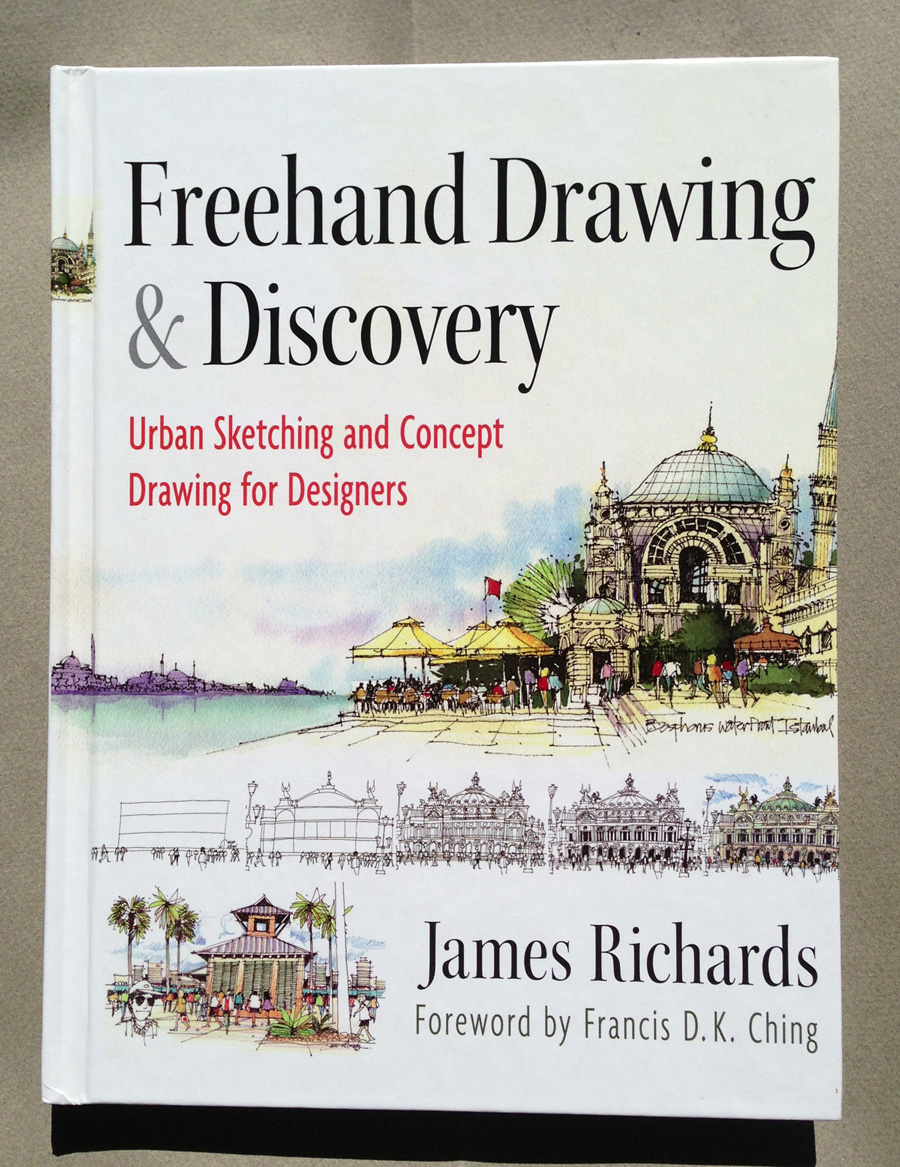
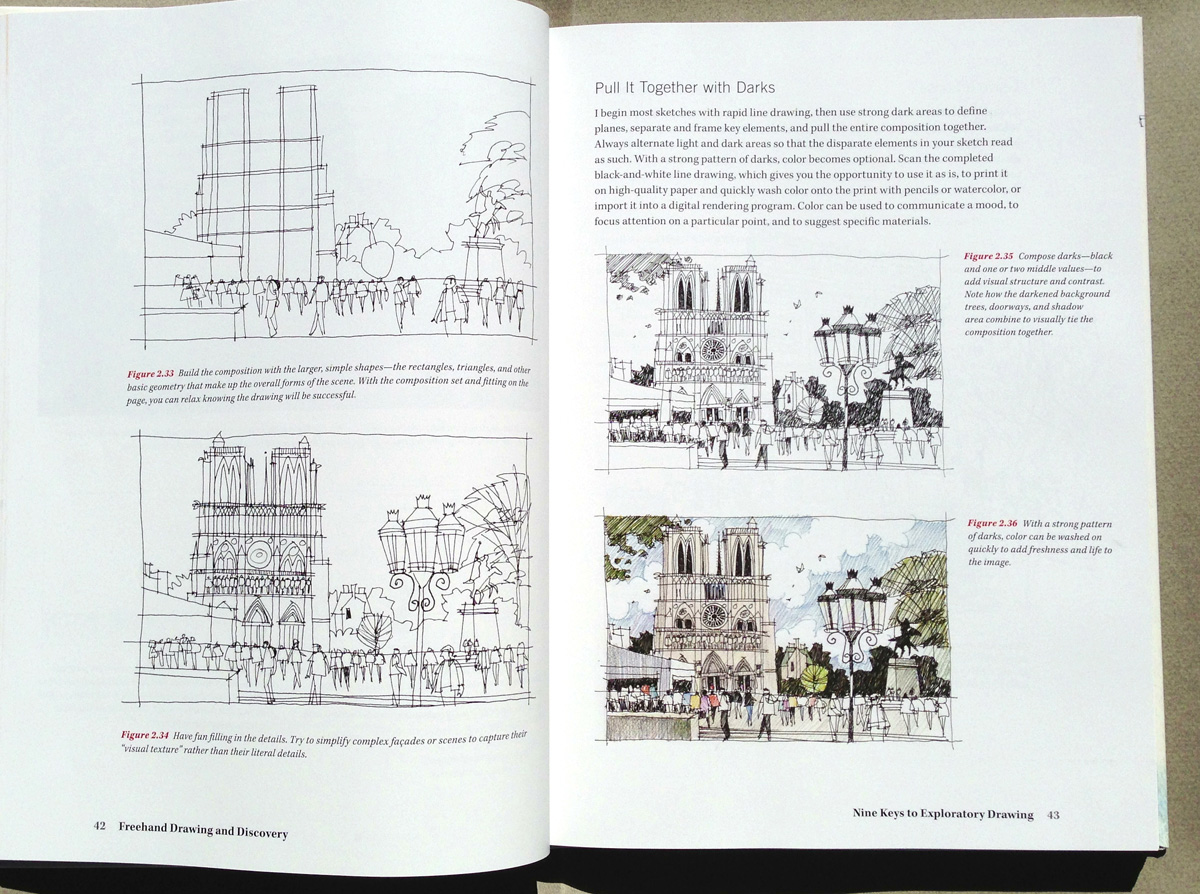
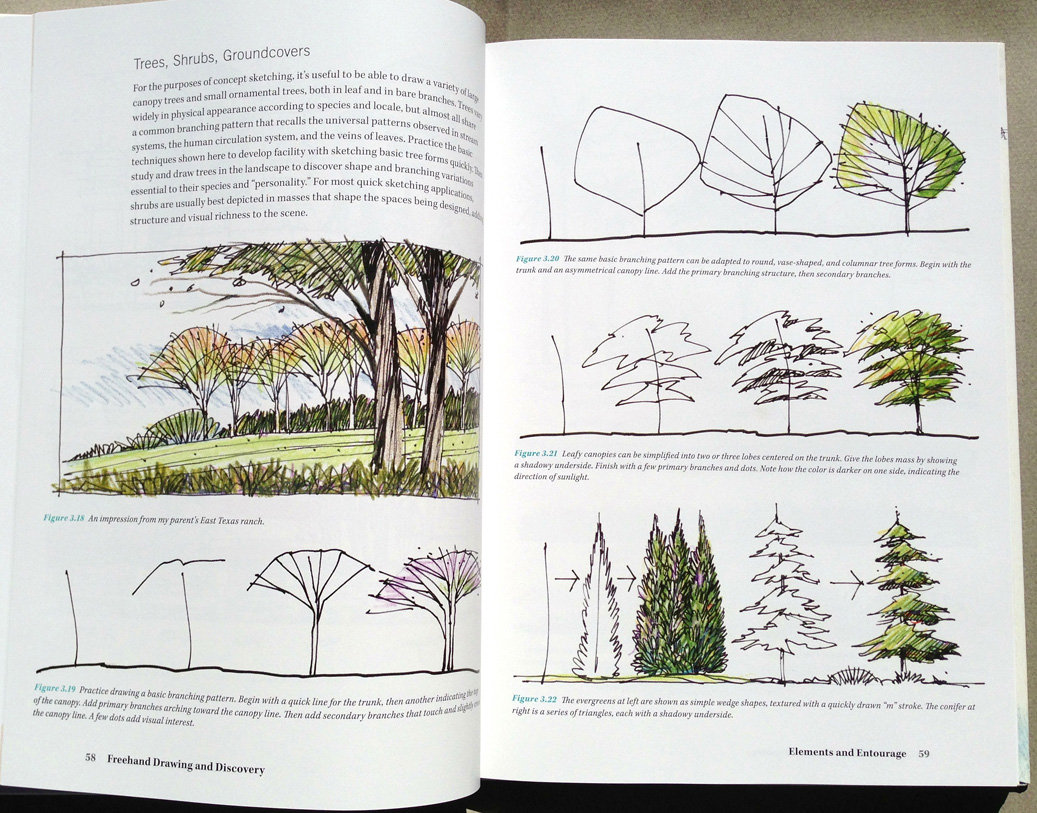
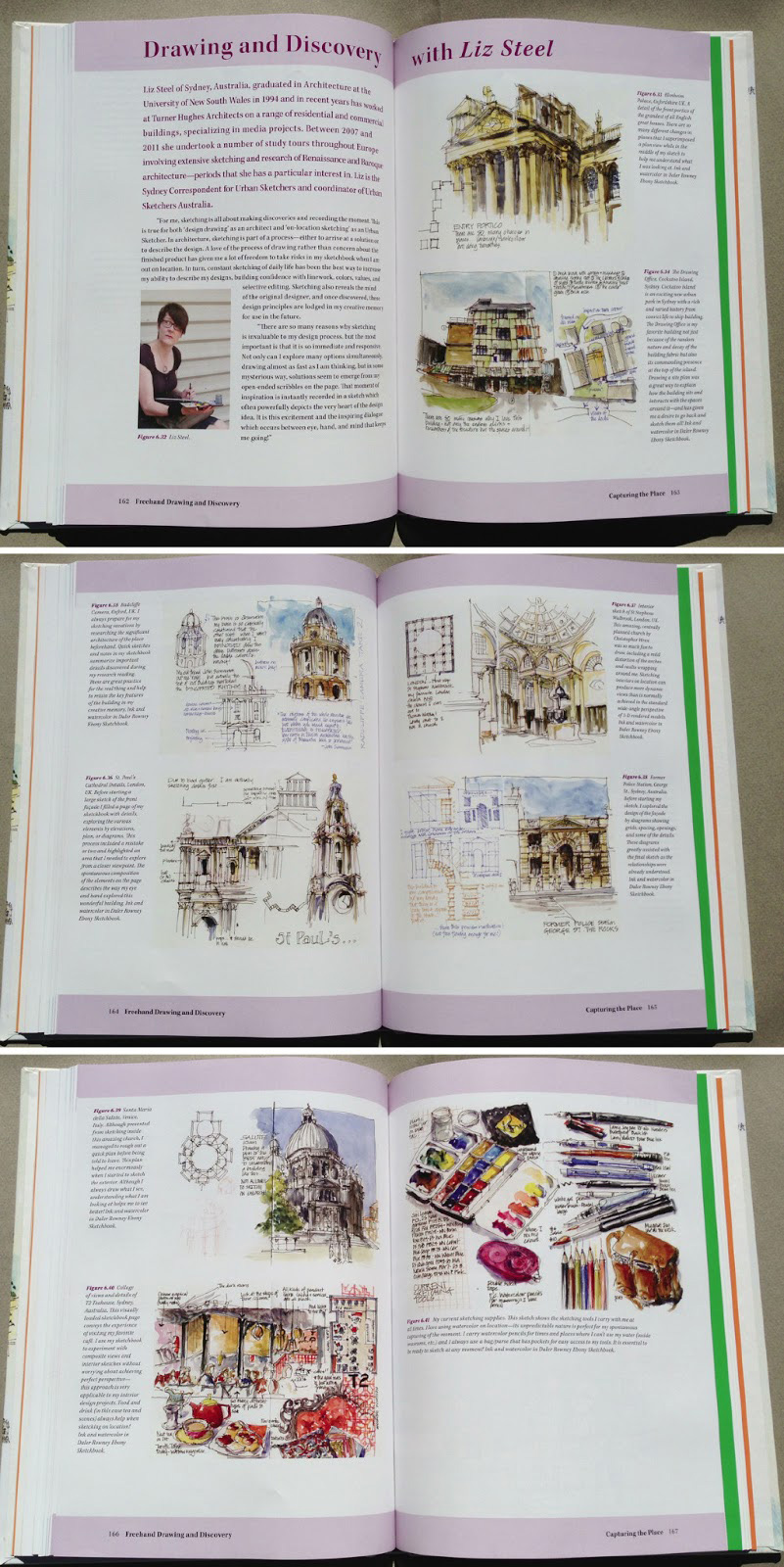



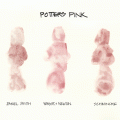
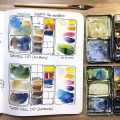
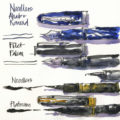
NEWSLETTER
Subscribe for first notification of workshop + online classes and more.